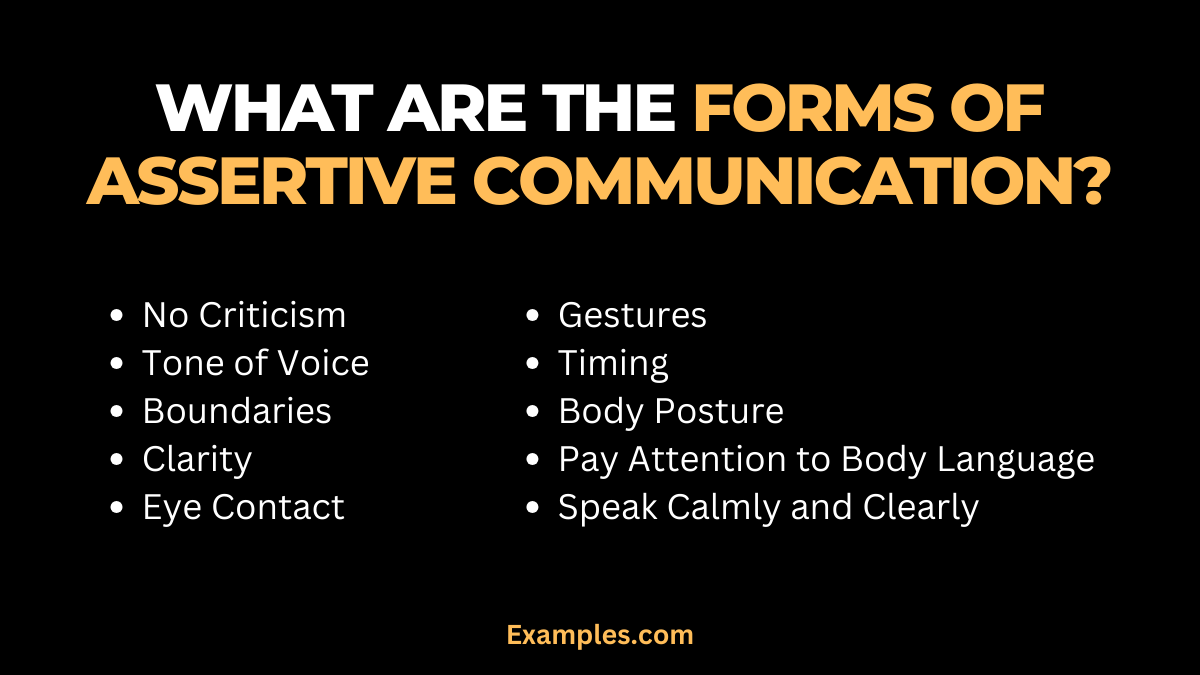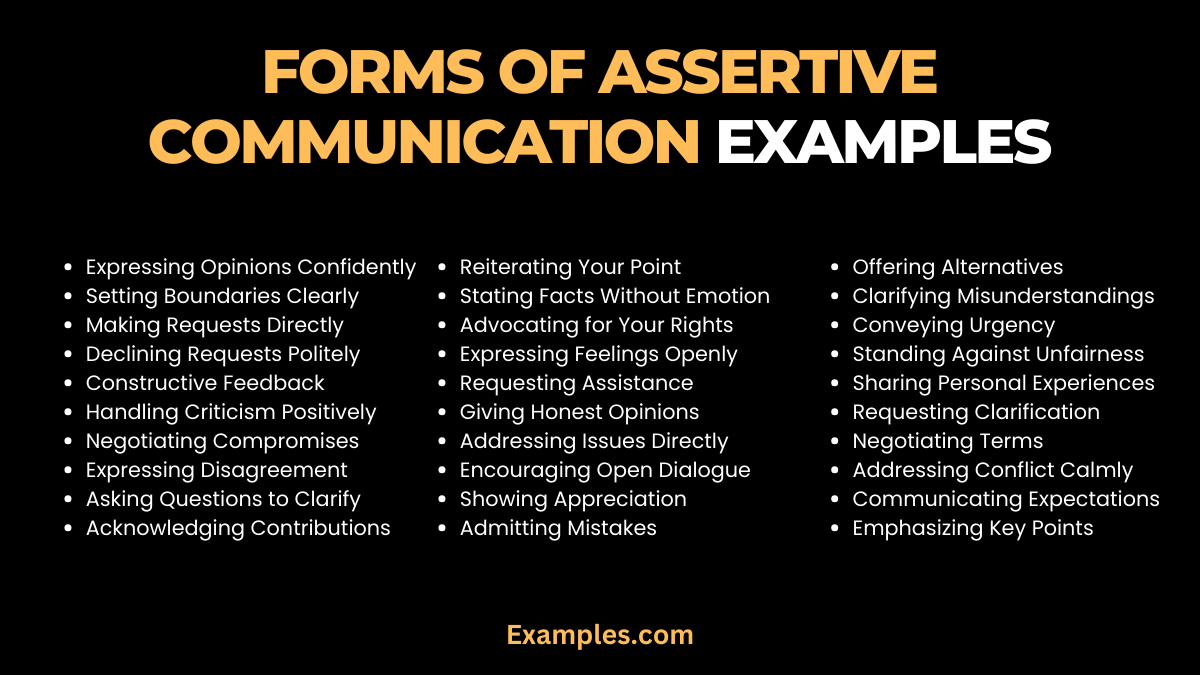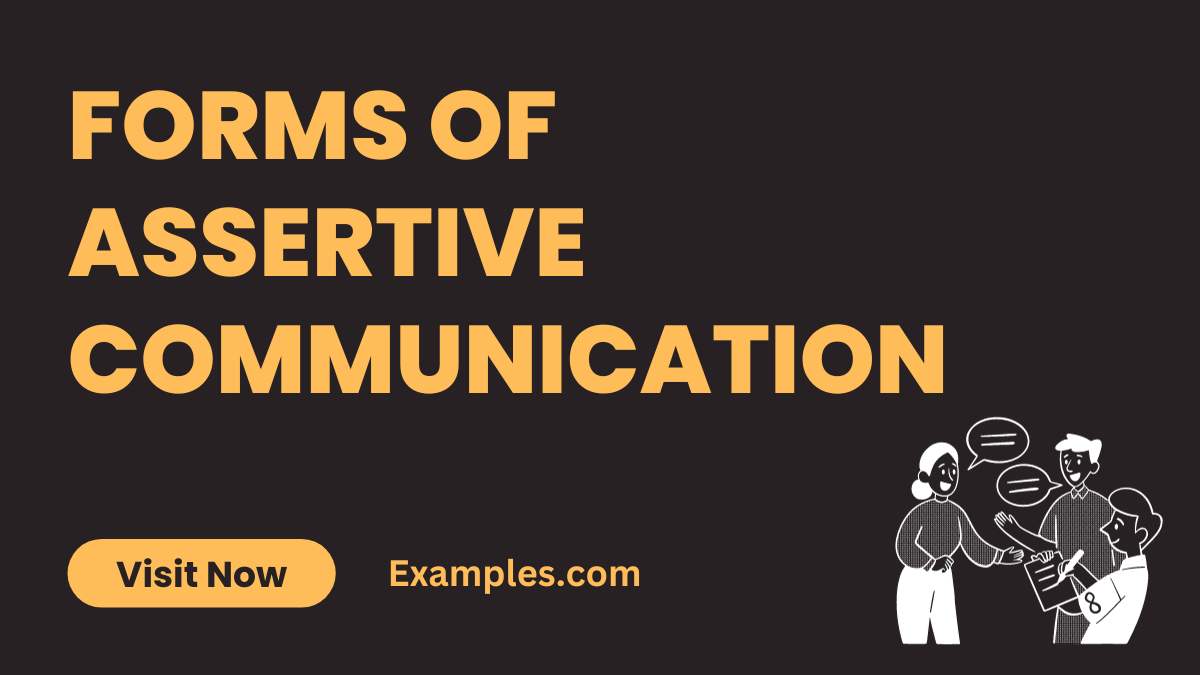Forms of Assertive Communication
Assertive communication, a key to successful interpersonal interactions, involves various forms that balance expressing oneself respectfully and listening to others. This guide delves into the different forms of assertive communication, providing communication examples to illustrate each style. From verbal expressions to non-verbal cues, it covers the spectrum of assertiveness, highlighting how to convey messages effectively while maintaining respect for others’ perspectives. Whether in personal relationships, professional environments, or daily transactions, mastering these forms empowers individuals to communicate confidently and constructively.
What are the Forms of Assertive Communication?

Assertive communication encompasses various forms that enable individuals to express themselves clearly and confidently, while respecting others’ perspectives. Here are some key forms:
Verbal Assertiveness
- Direct Conversation: Involves openly expressing thoughts and feelings in a straightforward manner.
- I Statements: Personalizing statements to express feelings without blaming or accusing others.
Non-Verbal Assertiveness
- Body Language: Using confident posture and gestures to complement verbal messages.
- Facial Expressions: Conveying sincerity and earnestness through facial cues.
Behavioral Assertiveness
- Setting Boundaries: Clearly defining personal limits and expectations.
- Active Listening: Engaging attentively with others, showing understanding and respect.
Each form plays a pivotal role in effective assertive communication, helping to foster mutual respect and understanding in various interactions.
30 Forms of Assertive Communication Examples

Assertive communication is a key skill, crucial for effective interactions in various settings. This guide explores 30 forms of assertive communication, each illustrated with unique examples and brief explanations. These forms demonstrate how to express oneself confidently and respectfully, ensuring that one’s message is clearly understood. The examples highlight the practical application of these skills in real-life scenarios, providing insight into how assertive communication can be effectively utilized to maintain healthy relationships, both personal and professional.
- Expressing Opinions Confidently: “I believe we should reconsider our strategy. My experience suggests a different approach might yield better results.”
- Setting Boundaries Clearly: “I appreciate your interest, but I need to keep my weekends free from work-related calls.”
- Making Requests Directly: “Could you please send me the report by tomorrow? It’s important for the meeting.”
- Declining Requests Politely: “I understand your need, but I’m unable to commit to this project at the moment.”
- Providing Constructive Feedback: “Your presentation was very informative, but adding more data could enhance its impact.”
- Handling Criticism Positively: “I appreciate your feedback. I’ll work on improving those areas.”
- Negotiating Compromises: “Let’s find a middle ground that suits both our needs.”
- Expressing Disagreement Respectfully: “I see your point, but I have a different perspective on this issue.”
- Asking Questions to Clarify: “Could you elaborate more on that point for better understanding?”
- Acknowledging Others’ Contributions: “Your input was crucial in making this project a success.”
- Reiterating Your Point: “To reiterate, my main concern is with the timeline of the project.”
- Stating Facts Without Emotion: “The data shows a 20% decrease, which we need to address.”
- Advocating for Your Rights: “I deserve equal opportunity for this promotion.”
- Expressing Feelings Openly: “I feel frustrated when my ideas are not considered.”
- Requesting Assistance: “I could use some help with this task, if you’re available.”
- Giving Honest Opinions: “Honestly, I think there’s a better solution to this problem.”
- Addressing Issues Directly: “Let’s discuss the misunderstanding to clear things up.”
- Encouraging Open Dialogue: “I encourage everyone to share their thoughts on this matter.”
- Showing Appreciation: “Thank you for your hard work and dedication.”
- Admitting Mistakes: “I was wrong in my approach, and I apologize.”
- Offering Alternatives: “If that doesn’t work for you, perhaps we could try this method.”
- Clarifying Misunderstandings: “To clarify, my intention was not to criticize, but to suggest improvements.”
- Conveying Urgency: “It’s important that we address this issue promptly.”
- Standing Up Against Unfairness: “I need to speak up; this decision seems unfair.”
- Sharing Personal Experiences: “In my experience, a different approach worked better.”
- Requesting Clarification: “Could you explain what you mean by that?”
- Negotiating Terms: “I agree, but let’s negotiate the terms to benefit us both.”
- Addressing Conflict Calmly: “Let’s resolve this conflict in a calm and rational manner.”
- Communicating Expectations: “I expect this task to be completed by next week.”
- Emphasizing Key Points: “The key issue here is the impact on our budget.”
What are the Important Forms of Assertive Communication?
Assertive communication is a balanced approach that respects both your own needs and those of others. It’s about expressing yourself effectively and standing up for your point of view, while also respecting the rights and opinions of others. This style of communication can be broken down into various components, each playing a crucial role in how effectively your message is conveyed.
No Criticism
Assertive communication focuses on the issue at hand rather than resorting to criticism of the person. It involves addressing problems in a way that is respectful and constructive, aiming for a solution rather than attributing blame.
Tone of Voice
The tone of voice in assertive communication should be confident and calm, conveying your message without aggression or passiveness. It’s about speaking with a level of assurance that shows you respect yourself and others.
Boundaries
Setting clear boundaries is a key aspect of assertive communication. It involves expressing your limits firmly and respectfully, ensuring others understand your stance without feeling disrespected.
Clarity
Clarity in communication is about being concise and to the point. It’s important to express your thoughts and needs clearly and directly, avoiding any ambiguity or misunderstanding.
Eye Contact
Maintaining appropriate eye contact shows confidence and sincerity. It helps in building trust and indicates that you are engaged and attentive.
Gestures
Using gestures can enhance your message, but they should be appropriate and non-threatening. Assertive communication uses gestures to complement the verbal message, not overpower it.
Timing
Choosing the right moment to communicate is as important as what you say. Assertive communication takes into account the timing to ensure the message is well-received.
Body Posture
Your body posture should reflect openness and confidence. Standing or sitting upright, without appearing rigid, can positively impact how your message is received.
Pay Attention to Body Language
Body language in assertive communication is about being aware of your own non-verbal cues and those of others. It’s crucial for understanding the complete message being communicated.
Speak Calmly and Clearly
Speaking in a calm and clear manner is vital. It helps in expressing your message effectively without causing unnecessary tension or conflict.
What are the Different Forms of Assertive Communication Styles?
Here are the Different Forms of Assertive Communication Styles:
Direct Communication in Assertive Communication
Direct communication is a hallmark of assertive styles, characterized by straightforward and honest expression. It avoids ambiguity, ensuring that the message is clear and easily understood. This style is particularly effective in professional environments, where clarity is crucial.
Open and Honest Expression
Open and honest expression is foundational to assertive communication. It involves sharing thoughts and feelings transparently, fostering trust and authenticity in interactions. This approach is vital in personal relationships, enhancing mutual understanding and respectful dialogue.
Non-Verbal Assertiveness
Non-verbal assertiveness includes body language and facial expressions that convey confidence and respect. It’s essential in reinforcing the spoken message, making the communication more impactful and believable.
Empathetic Listening
Empathetic listening in assertive communication involves understanding and acknowledging others’ perspectives. This form of listening builds rapport and trust, essential for effective and respectful communication.
Firm Boundary Setting
Firm boundary setting is key in assertive communication, where personal limits are clearly defined and respected. It’s essential for maintaining healthy dynamics in both personal and professional relationships.
Positive Affirmation
Positive affirmation involves acknowledging and appreciating others. This form of communication reinforces positive behaviors and builds a supportive atmosphere.
What are the Parts of Assertive Communication?
Here are the Parts of Assertive Communication:
Verbal Expression
Verbal expression in assertive communication involves using clear, direct language. This includes choosing words that precisely convey your message, ensuring your intent is understood without ambiguity.
Body Language
Body language is a critical component. It encompasses maintaining eye contact, a confident posture, and gestures that align with your spoken words, enhancing the effectiveness of your message.
Listening Skills
Effective assertive communication also requires active listening. This means fully focusing on the speaker, understanding their message, and responding thoughtfully, demonstrating respect and engagement in the conversation.
Emotional Control
Maintaining emotional control is essential. It involves managing your emotions effectively to ensure that your message is conveyed calmly and rationally, reflecting maturity and self-awareness in your interactions.
In concluding the article on forms of assertive communication, it’s important to emphasize the transformative power of mastering assertive communication styles. Assertive communication is a vital social skill that balances effective communication with respect for others. It allows individuals to clearly state their wants, needs, and boundaries, fostering an environment of mutual understanding and respect. This skill is not only beneficial in personal interactions but also in professional settings, contributing to more effective and harmonious relationships.
For more information on the importance of assertive communication and its impact on stress reduction, visit the Mayo Clinic’s insightful article on “Reducing Stress through Assertive Communication“. Additionally, Psychology Today offers an in-depth exploration of assertiveness as a social skill and its benefits for personal development in their article on “Assertiveness“. These resources provide valuable insights into how assertive communication can positively transform personal and professional interactions????????.



